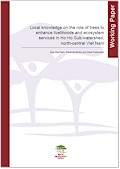| Working Paper Series |
 |
|
| Title | Local knowledge on the role of trees to enhance livelihoods and ecosystem services in Ho Ho Sub-watershed, north-central Viet Nam | | Author | Dam Viet Bac, Rachmat Mulia and Delia Catacutan | | Year | 2015 | | Publisher | World Agroforestry Centre (ICRAF) Southeast Asia Regional Program | | City of Publication | Hanoi, Vietnam | | Series Number | Working paper 218 | | Number of Pages | 13 | | Call Number | WP0200-16 | | Keywords | Environmental services, livelihood, local knowledge, role of trees, sub-watershed |
|
| Abstract: |
| Understanding how local people view and value the role of trees in enhancing livelihoods and
environmental quality is the key to increasing resilience in agricultural landscapes through tree
planting. In the Ho Ho sub-watershed, north-central Viet Nam, which is highly exposed to climate
change and variability, we investigated local knowledge on the role of trees that involved people
upstream and downstream in the sub-watershed. The respondents were requested to identify the
different roles of tree-based and annual crop systems in their landscape to livelihood and the
environment, and then to rank these roles to reveal the primary function of each landuse system. We
found that local knowledge on the roles of each landuse type, both in upstream and downstream
communes, was influenced by the household land holding size and the actual contribution to household
income as well. This, for example, explains the higher appreciation of acacia than agarwood in terms of
livelihood and environmental functions. In the sub-watershed, the average land holding size per
household for acacia plantation was 1.3 ha, while agarwood trees were planted in homegardens with a
delayed harvesting time (15 years after planting compared to 7 years for acacia). Different
responsibilities in agricultural activities between males and females in the family, contributed to
contrasting responses between the male and female groups on the role of tree-based and annual crop
systems in household income. Men regarded annual crops as a more important source of income than
trees, whereas women asserted the opposite. In the sampled households, financial management and
private consumption provision were two tasks mostly handled by women, and this likely explains the
gender sensitivity. We conclude that local people in the upstream and downstream communes of the
sub-watershed recognised well the important roles of trees to livelihood and environmental quality, but
in actual implementation, they always prioritised livelihood over environmental issues, especially in
relation to tree planting on their own land. Environmental issues were only an option considered for
unallocated areas such as protection forest, or for allocated lands not suitable for planting due to
physical barriers such as high elevation or steep slopes. |
|